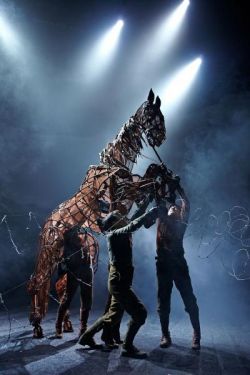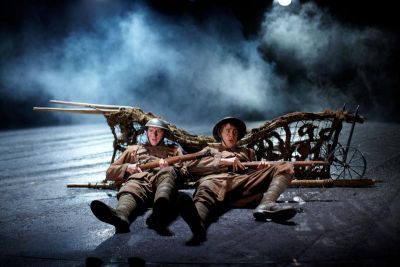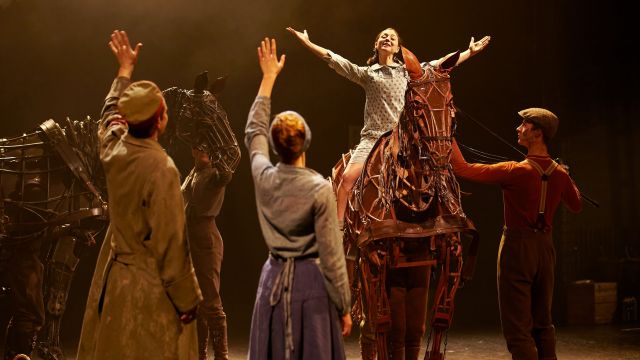War Horse
A story that begins with the rivalry between two farmers. One wins an auction and buys a foal he can ill afford – and the foal is a ‘hunter’, not a farm horse that could pull a wagon or a plough. Nevertheless, the farmer’s son Albert (Scott Miller), only sixteen, calls the horse ‘Joey’ and the two are soul mates, bonded forever. Suddenly it’s 1914 and there’s an urgent need for horses, thousands of them – and Joey is sold and gone. And when Joey is gone, our hearts sink. Albert is bereft, heartbroken, of course, but we know where Joey is going. We are plunged into the explosions, the terror, the fire and mud, the chatter of machine guns, and the stubborn resistance to the fact that this is a mechanised war – the clash of old and heartless new… It is a story of innocence, exemplified by the horses, against cruel lunacy.
 The story, as a story, is simple and could easily fall into sentimentality. It doesn’t. Why this show grabs you by the throat is the way it is told – and the horses. Albert’s quest to find Joey is straightforward and touchingly naïve, but it is war, skilfully, at times almost overwhelmingly created by Tom Morris’ and Marianne Elliott’s direction, Toby Sedgwick’s movement of his big cast, Rae Smith’s design and drawings, Christopher Shutt’s sound design and Paule Constable’s lighting. All work semlessly to provide constant jeopardy, moments of fearful humour – and indeed irony. We witness unexpected connections between ‘enemies’, and British obdurate conceit in a cavalry charge – Joey and and another horse, Tophorn - in the lead – against German machine guns and barbed wire. Only in Act II, do we meet a character, German Captain Müller (Christopher Naylor) who seems to understand the chaotic madness of what is going on (the best human character in the show, for me) and, in a kind of despair, values the horses over blinkered or mad doomed humans.
The story, as a story, is simple and could easily fall into sentimentality. It doesn’t. Why this show grabs you by the throat is the way it is told – and the horses. Albert’s quest to find Joey is straightforward and touchingly naïve, but it is war, skilfully, at times almost overwhelmingly created by Tom Morris’ and Marianne Elliott’s direction, Toby Sedgwick’s movement of his big cast, Rae Smith’s design and drawings, Christopher Shutt’s sound design and Paule Constable’s lighting. All work semlessly to provide constant jeopardy, moments of fearful humour – and indeed irony. We witness unexpected connections between ‘enemies’, and British obdurate conceit in a cavalry charge – Joey and and another horse, Tophorn - in the lead – against German machine guns and barbed wire. Only in Act II, do we meet a character, German Captain Müller (Christopher Naylor) who seems to understand the chaotic madness of what is going on (the best human character in the show, for me) and, in a kind of despair, values the horses over blinkered or mad doomed humans.
But really, the wonder of this show is the horses. The puppeteers – five to a horse – clearly studied horses intently: they not only move the horses, including Joey as a foal, in such a way that they go beyond merely ‘lifelike’. They supply all the horse sounds too, so beautifully that it is like language. Not only do we soon forget that the puppeteers are even there, the puppets themselves are characters who think, assess, feel, react, are happy, angry, terrified, tender.
It was a fascinating, bold but prescient decision, first by director Tom Morris and then by Nicholas Hytner at the National Theatre to go with the adaptation of Morpurgo’s 1982 novel – a slim book ostensibly for children. A WWI story about a boy and his horse. But the fascination with WWI continues - the heroism, the sacrifices, the stupidity, the mud and the blood. Rarely are the horses, millions of them killed and maimed, mentioned in the numerous histories, but human beings’ response to horses is emotional, almost visceral.
 So there must have been more than an instinct at the National Theatre that this would work – because such great resources were then devoted to the project: the collaboration with Handspring Puppet Company, and the creation of the astonishing life size puppets, the lengthy but necessary rehearsal time, the cast of thirty-six, the projected simple but evocative drawings and animations, and the powerful lighting and sound design. If the decision for all that was in any sense a gamble in 2007, it has paid off over and over. What we are seeing now, with this completely imported show, is its second run here and just one stop on a second world tour that will add new (and returning) audiences to the numbers who have seen the show in ninety-seven cities in eleven countries. There have been horse stories before particularly in cinema (National Velvet, Phar Lap, Sea Biscuit), but with War Horse, the puppets make Joey and Tophorn characters in their own right and more than equal to the humans.
So there must have been more than an instinct at the National Theatre that this would work – because such great resources were then devoted to the project: the collaboration with Handspring Puppet Company, and the creation of the astonishing life size puppets, the lengthy but necessary rehearsal time, the cast of thirty-six, the projected simple but evocative drawings and animations, and the powerful lighting and sound design. If the decision for all that was in any sense a gamble in 2007, it has paid off over and over. What we are seeing now, with this completely imported show, is its second run here and just one stop on a second world tour that will add new (and returning) audiences to the numbers who have seen the show in ninety-seven cities in eleven countries. There have been horse stories before particularly in cinema (National Velvet, Phar Lap, Sea Biscuit), but with War Horse, the puppets make Joey and Tophorn characters in their own right and more than equal to the humans.
Michael Brindley
Photographer: Brinkhoff Mögenburg
Subscribe to our E-Newsletter, buy our latest print edition or find a Performing Arts book at Book Nook.

